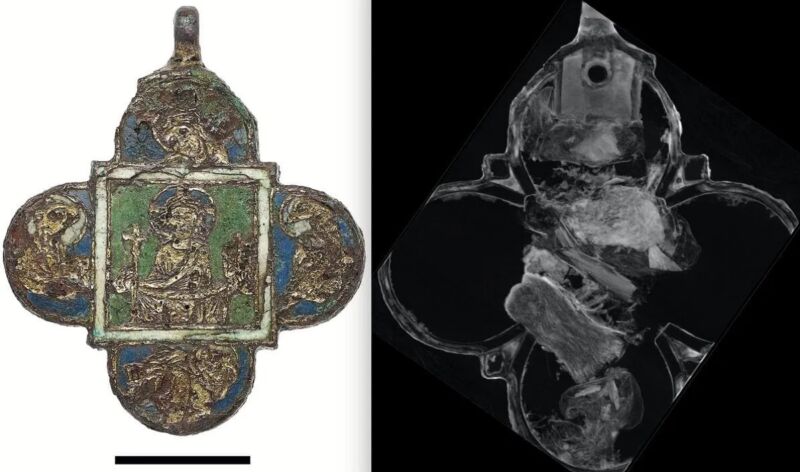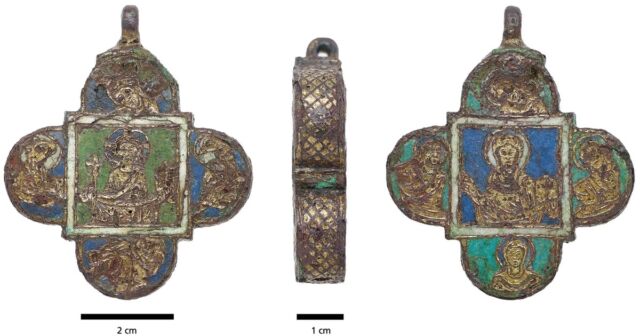
Sabine Steidl, RGZM/Burkhard Schillinger, MLZ
In 2008, while excavating a medieval rubbish pit in Mainz, Germany, archaeologists discovered a heavily corroded pendant likely made in the late 12th century. But they didn’t want to open the pendant to find out what might be inside, lest they damage an already fragile artifact. Now technology comes to the rescue. Researchers at the Technical University of Munich scanned the pendant using neutron tomography, among other things, and found that it contained bone fragments – likely religious relics, i.e. the supposed bones of saints. The findings were published at the interim meeting of the International Council of Museums-Committee for Conservation (ICOM-CC) Metals Working Group.
Neutron tomography works in much the same way as X-ray and gamma-ray imaging methods, except that it uses a neutron beam. One shoots a beam of radiation at the target object, and some parts interact with the sample while others pass through it. The latter collides with an imaging target to create a so-called attenuation pattern – essentially an image of the sample’s interior. Neutron tomography is not as sensitive to the density of materials as X-rays and gamma rays, and unlike those methods, neutrons strongly interact with very light elements such as hydrogen. So some things that are easily visible with neutron imaging can be challenging or impossible to see with X-ray imaging (and vice versa).
The techniques can be complementary and are especially useful for imaging archaeological or paleontological artifacts because they do not damage or destroy the original object. For example, in December 2021, researchers combined X-ray microtomography — which uses X-rays to create cross-sections of a physical object — and neutron tomography to create a highly detailed 3D model of a 365-million-year-old ammonite fossil from the Jurassic period, revealing internal muscles never seen before. Among other findings, they observed paired muscles extending from the ammonite’s body, which they suspect probably caused the animal to retreat further into its shell to avoid predators.

Sabine Steidl, RGZM
The gilded brass pendant in Mainz is just 6 inches high and wide and is shaped like a quatrefoil (a shape common in traditional Christian symbolism). The front and back are enameled using a technique known as champlevé, in which gutters are cut or etched into the surface of a metal object and then filled with porcelain enamel. The uncovered parts are gilded, a common practice in the Middle Ages. One side represents Jesus, with four evangelists depicted in the four rounded ends. The other side shows Mary surrounded by four female saints.
The team first analyzed the surface using a combination of micro X-ray fluorescence and Raman spectroscopy to identify all the elements present. And infrared spectroscopy revealed a tiny piece of beeswax. But “We couldn’t just open the trailer and look inside,” says Matthias Heinzel, restorer at Leibniz-Zentrum für Archäologie (LEIZA), part of the Technical University of Munich. “The object and especially the lock. The mechanism has been seriously damaged by centuries of corrosion, and opening it would mean that it would be irrevocably destroyed.”
Using neutron imaging, the pendant was preserved and five small reliquary packages of silk and linen with bone splinters were revealed. heinzel et al. identified individual elements of the sample by triggering them with a gamma-ray technique called prompt gamma activation analysis (PGAA). “We can’t say whether these bone fragments belong to a saint, and if so, which one,” Heinzel said. “Usually, relic wrappers contain a strip of parchment on which the name of the saint is written. In this case, unfortunately, we can’t see any.”
The now fully restored pendant is currently on display at the Mainz State Museum.

